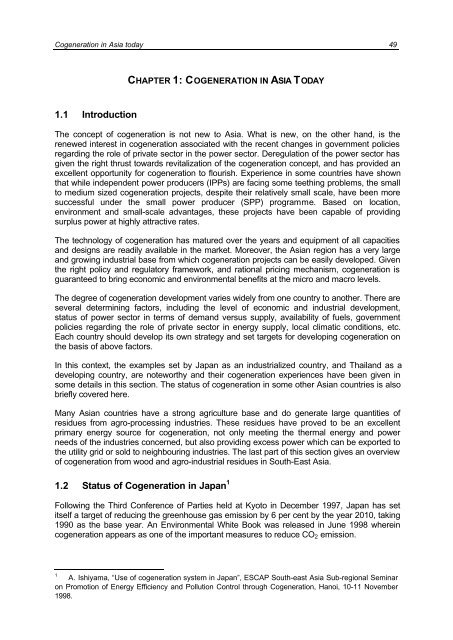part 1: overview of cogeneration and its status in asia - Fire
part 1: overview of cogeneration and its status in asia - Fire
part 1: overview of cogeneration and its status in asia - Fire
Create successful ePaper yourself
Turn your PDF publications into a flip-book with our unique Google optimized e-Paper software.
Cogeneration <strong>in</strong> Asia today 49<br />
1.1 Introduction<br />
CHAPTER 1: COGENERATION IN ASIA TODAY<br />
The concept <strong>of</strong> <strong>cogeneration</strong> is not new to Asia. What is new, on the other h<strong>and</strong>, is the<br />
renewed <strong>in</strong>terest <strong>in</strong> <strong>cogeneration</strong> associated with the recent changes <strong>in</strong> government policies<br />
regard<strong>in</strong>g the role <strong>of</strong> private sector <strong>in</strong> the power sector. Deregulation <strong>of</strong> the power sector has<br />
given the right thrust towards revitalization <strong>of</strong> the <strong>cogeneration</strong> concept, <strong>and</strong> has provided an<br />
excellent opportunity for <strong>cogeneration</strong> to flourish. Experience <strong>in</strong> some countries have shown<br />
that while <strong>in</strong>dependent power producers (IPPs) are fac<strong>in</strong>g some teeth<strong>in</strong>g problems, the small<br />
to medium sized <strong>cogeneration</strong> projects, despite their relatively small scale, have been more<br />
successful under the small power producer (SPP) programme. Based on location,<br />
environment <strong>and</strong> small-scale advantages, these projects have been capable <strong>of</strong> provid<strong>in</strong>g<br />
surplus power at highly attractive rates.<br />
The technology <strong>of</strong> <strong>cogeneration</strong> has matured over the years <strong>and</strong> equipment <strong>of</strong> all capacities<br />
<strong>and</strong> designs are readily available <strong>in</strong> the market. Moreover, the Asian region has a very large<br />
<strong>and</strong> grow<strong>in</strong>g <strong>in</strong>dustrial base from which <strong>cogeneration</strong> projects can be easily developed. Given<br />
the right policy <strong>and</strong> regulatory framework, <strong>and</strong> rational pric<strong>in</strong>g mechanism, <strong>cogeneration</strong> is<br />
guaranteed to br<strong>in</strong>g economic <strong>and</strong> environmental benef<strong>its</strong> at the micro <strong>and</strong> macro levels.<br />
The degree <strong>of</strong> <strong>cogeneration</strong> development varies widely from one country to another. There are<br />
several determ<strong>in</strong><strong>in</strong>g factors, <strong>in</strong>clud<strong>in</strong>g the level <strong>of</strong> economic <strong>and</strong> <strong>in</strong>dustrial development,<br />
<strong>status</strong> <strong>of</strong> power sector <strong>in</strong> terms <strong>of</strong> dem<strong>and</strong> versus supply, availability <strong>of</strong> fuels, government<br />
policies regard<strong>in</strong>g the role <strong>of</strong> private sector <strong>in</strong> energy supply, local climatic conditions, etc.<br />
Each country should develop <strong>its</strong> own strategy <strong>and</strong> set targets for develop<strong>in</strong>g <strong>cogeneration</strong> on<br />
the basis <strong>of</strong> above factors.<br />
In this context, the examples set by Japan as an <strong>in</strong>dustrialized country, <strong>and</strong> Thail<strong>and</strong> as a<br />
develop<strong>in</strong>g country, are noteworthy <strong>and</strong> their <strong>cogeneration</strong> experiences have been given <strong>in</strong><br />
some details <strong>in</strong> this section. The <strong>status</strong> <strong>of</strong> <strong>cogeneration</strong> <strong>in</strong> some other Asian countries is also<br />
briefly covered here.<br />
Many Asian countries have a strong agriculture base <strong>and</strong> do generate large quantities <strong>of</strong><br />
residues from agro-process<strong>in</strong>g <strong>in</strong>dustries. These residues have proved to be an excellent<br />
primary energy source for <strong>cogeneration</strong>, not only meet<strong>in</strong>g the thermal energy <strong>and</strong> power<br />
needs <strong>of</strong> the <strong>in</strong>dustries concerned, but also provid<strong>in</strong>g excess power which can be exported to<br />
the utility grid or sold to neighbour<strong>in</strong>g <strong>in</strong>dustries. The last <strong>part</strong> <strong>of</strong> this section gives an <strong>overview</strong><br />
<strong>of</strong> <strong>cogeneration</strong> from wood <strong>and</strong> agro-<strong>in</strong>dustrial residues <strong>in</strong> South-East Asia.<br />
1.2 Status <strong>of</strong> Cogeneration <strong>in</strong> Japan 1<br />
Follow<strong>in</strong>g the Third Conference <strong>of</strong> Parties held at Kyoto <strong>in</strong> December 1997, Japan has set<br />
<strong>its</strong>elf a target <strong>of</strong> reduc<strong>in</strong>g the greenhouse gas emission by 6 per cent by the year 2010, tak<strong>in</strong>g<br />
1990 as the base year. An Environmental White Book was released <strong>in</strong> June 1998 where<strong>in</strong><br />
<strong>cogeneration</strong> appears as one <strong>of</strong> the important measures to reduce CO2 emission.<br />
1<br />
A. Ishiyama, “Use <strong>of</strong> <strong>cogeneration</strong> system <strong>in</strong> Japan”, ESCAP South-east Asia Sub-regional Sem<strong>in</strong>ar<br />
on Promotion <strong>of</strong> Energy Efficiency <strong>and</strong> Pollution Control through Cogeneration, Hanoi, 10-11 November<br />
1998.









